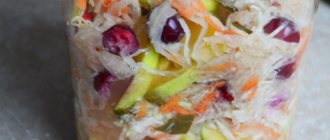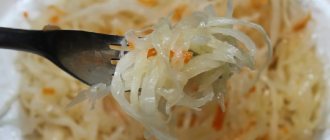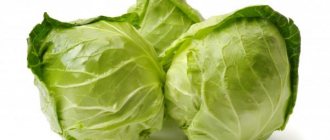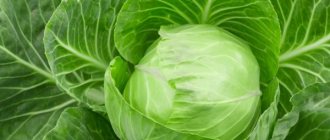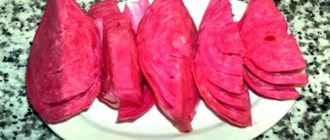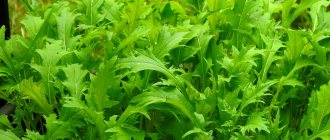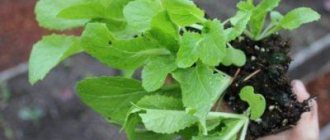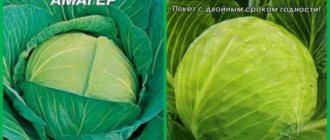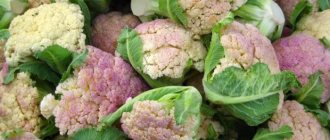The season for sauerkraut has long begun in late autumn, when the heads of cabbage collected in the fields and beds have already produced a sufficient amount of natural sugar, due to which lactic acid is released. Today, plastic buckets and bags with a very popular product are sold all year round. But often it has a very distant relation to real sauerkraut. And its benefits for the body are reduced to zero. Who monitors the quality of the goods and is it dangerous to buy blanks from private traders? The "R" correspondent was puzzled by the question: what would be better - buy pickles or cook it yourself?
Reasons for darkening of sauerkraut
Well-fermented cabbage has a white color without defects, a pronounced aroma, taste and crunchiness. When preparing such a snack, even minor details are important. A slight deviation from the recipe will lead to spoilage of the dish and its darkening.
There are several reasons why cabbage darkened when salted:
- incorrect quantity and quality of salt;
- variety unsuitable for pickling;
- non-compliance with temperature conditions and fermentation time;
- salting without oppression;
- oak containers;
- oxygen access;
- active development of dangerous microorganisms.
Amount of salt
Pickling is impossible without salt - it is this ingredient that eliminates dangerous microorganisms and helps enhance the effect of lactic acid. Salt is a natural preservative that will protect the product from spoilage.
Important! Coarse table salt without additives is suitable for fermentation.
A lack of salt leads to a slowdown in the fermentation process, and an excess leads to the neutralization of beneficial bacteria. Experienced housewives recommend using 20-24 g of salt per 1 kg of vegetables.
Iodized salt
The use of iodized and Himalayan salt with additives changes the chemical processes that occur during fermentation. As a result, a change in the color and taste of the snack.
Variety
Choosing the right variety is the key to successful fermentation. The color of the snack will change if the hostess chose a low-quality vegetable for preparation. Preference is given to sweetish mid-late or late varieties: Nadezhda, Podarok, Slava.
For fermentation, well-ripened, not frozen, dense heads of cabbage are used. It is important that there are no voids inside. The leaf color should be white or slightly yellowish.
Important! Frozen, heavily damaged and contaminated heads of cabbage are not suitable for pickling.
Unsuitable temperature
The entire fermentation process is divided into 3 stages:
- The first stage is characterized by cloudiness of the workpiece and increased formation of gases. During this period, beneficial bacteria actively multiply. A temperature of +17…+24°C is considered favorable for the life of microorganisms. If the values are lower, this will slow down the fermentation process, and if higher, it will contribute to the appearance of dangerous bacteria.
- During the second stage, lactic acid is released and negative processes slow down. The optimal temperature is +20°C. Thanks to this indicator, the vegetable accumulates the maximum amount of vitamin C.
- The third stage is post-fermentation. The required temperature is 0…-2°C. Increasing levels will lead to the formation of mold, which will spoil the product.
Fermentation time
Each stage differs in the chemical processes that occur and the fermentation time.
If you adhere to the recommended temperature, then:
- the first stage will take 2-3 days;
- the second will last 5-7 days;
- the third - several months.
No oppression
Oppression is used to compact ingredients and block oxygen access . The top layer of the workpiece turns black due to the weathering of the liquid and the entry of air. What should be the weight of an object used as a weighting agent? Previously, in Rus', housewives used ordinary scalded cobblestones, the weight of which was equal to 1/10 of the mass of cabbage.
Now many people ferment vegetables in glass jars. Water poured into a plastic bag or a smaller jar is used as pressure.
Ignoring gas relief
Beginning housewives are perplexed as to why they need to pierce the cabbage during fermentation. During fermentation, a large volume of gases is released, which begins to displace the brine. If you do not release gases from the jar, the color deteriorates and the taste begins to taste bitter.
The cabbage is pierced with a wooden stick for 2-3 days - as soon as foam appears on the surface of the container. The procedure is carried out 1-2 times a day. Make sure the stick reaches the bottom of the container.
They don't add enough salt
Another main mistake during fermentation is the incorrect proportions of salt and cabbage. A small amount of white matter cannot provide the impetus to start the fermentation process. After all, if there is not enough salt, then the cabbage will not release enough juice. And when there is enough of it, then a lot of brine is formed. It is necessary to place the jar in a deep container in advance so that excess liquid drains there.
For successful fermentation, it is more correct to use rock salt (coarse salt, without additives) at a rate of about two tablespoons of white powder per 1 kg of cabbage. Over-salted workpiece also does not bode well. The sauerkraut will be too salty or begin to taste bitter. This situation can be easily corrected by adding apples and carrots to it.
So, follow all the recommendations, then you will get crispy and aromatic sauerkraut without flaws. It will also delight you with excellent taste and add to your health.
Is it possible to eat this cabbage?
Physical processes that cause darkening:
- Weathering of brine . During the fermentation process, the brine evaporates, so the top layer of vegetables turns black - it is removed, the rest of the cabbage can be eaten.
- Adding carrots . A large amount of this ground vegetable will affect the color of the workpiece. Despite the darkening, it is suitable for consumption.
- Iodized salt . Using salt with additives changes the chemical processes, which leads to the darkening of the snack and deprives it of its savory taste.
- Storing cabbage in metal containers.
- Excessive mucus production. This problem occurs when lactic bacteria actively multiply. If the mucus is clear, the snack can be consumed.
Biological reasons:
- activity of pathogenic microflora due to excess temperature;
- the appearance of mold;
- fungal activity caused by insufficient salt and temperature disturbances;
- formation of rot.
What to do with it
If the reason for the darkening of the product is due to physical processes, it can be consumed. But if the cabbage has changed its color for biological reasons, it is disposed of.
Important! A color change to red indicates fungal activity. This product cannot be eaten. Extinguishing the situation will not save the situation.
Sauerkraut that has darkened greatly cannot be stored. If it begins to turn black due to mold, it is not enough to remove the fungus on top - it has already affected the entire workpiece. It's better to throw it away.
Factors that may contribute to mold growth.
Mold is rare, but there are some factors that need to be controlled to reduce the likelihood of mold formation.
Quality of vegetables.
It is better to use fresh and organic vegetables. Old, stale vegetables cannot ferment well.
Salt content.
Proper salt content in each batch of vegetables is important to prevent mold.
Fermentation temperature.
Temperatures between 18° and 20°C are ideal.
How to ferment cabbage correctly so that it does not darken
Making sauerkraut is a simple process. But there are several nuances that can completely ruin the product. Preparation for cooking begins with the selection of cabbage.
White cabbage is used for pickling . Choose a mature, light head of cabbage with dense and thin leaves. To prevent darkening, remove the top leaves. If the housewife adds carrots, it is better not to grate them, but to cut them into strips.
Peculiarity. Finely grated carrots release a lot of juice, which will change the color of the product.
Grapes, apples, beets, red bell peppers, lingonberries or cranberries are also added to sauerkraut. To prevent these ingredients from affecting the color of the vegetable, they are marinated separately and mixed after readiness.
Spices diversify the taste of the snack: bay leaf, black pepper, coriander, cumin seeds and dill. Seasonings are mixed together with salt and then added to the brine.
The key to crispy cabbage is the brine. Liquid affects not only the color of the vegetable, but also its structure. As soon as the brine begins to erode, salt water is poured into the container.
For a piquant taste, many housewives add sugar to the brine. For 1 liter of water, 1 tbsp is enough. l. sugar and 1.5 tbsp. l. salt.
Don’t forget about the need to release gas from the cabbage. During the fermentation period, it is pierced in several places with a sterile wooden stick (suitable for sushi).
What container should I use to ferment cabbage? During fermentation, organic acids are released that can spoil the container. Therefore, glass jars, enamel or wooden dishes are used. Keep in mind that due to fermentation in wooden barrels, the cabbage will lose its snow-white color and turn gray.
Characteristics of a properly prepared snack:
- equally cut strips of cabbage;
- uniform distribution of additives (carrots, apples, cranberries, grapes);
- cabbage structure is dense;
- crispness and juiciness;
- aroma - spicy, with fresh notes, no unpleasant odors;
- taste - soft, sweet and sour, without bitterness;
- pickle - spicy;
- color - from white to yellowish.
First aid measures
At home, it is impossible to know for sure what caused the poisoning: nitrates contained in cabbage or a spoiled product. Therefore, seeking medical help is a necessary measure. Otherwise, complications may develop.
But even before consulting a doctor, it is necessary to take measures aimed at eliminating the symptoms of the disease. Their main purpose is to help the body remove toxic substances from the body.
- Rinse the stomach . To do this, you need to prepare a weak solution of potassium permanganate (pure water at room temperature will do), you will need 3-4 liters. The poisoned person is given about a liter or a half of the prepared solution to drink, after which they induce vomiting by lightly pressing on the root of the tongue. Such actions are repeated until the vomit is completely cleared of food debris.
- Rinse the intestines . The intestinal cavity should be cleaned with an enema. To carry out the procedure, a weakly diluted solution of potassium permanganate or clean water is also used.
- Take an enterosorbent drug . Such agents are necessary for binding and removing toxins. Moreover, they are completely safe. You can use any sorbent that is stored in your home medicine cabinet: Smecta, Polysorb, Enterosgel, Polypefan, Activated carbon.
- Provide plenty of fluids . The main danger of poisoning is dehydration! To prevent it, you need to drink a lot: in small portions, 3-4 tablespoons every 20-30 minutes.
- Restore water-salt balance . With diarrhea and vomiting, the body is deprived of beneficial microelements. To replenish their supply, you need to take special rehydration products. The most effective are: Regidron, Oralit, Glucosolan, Peroral.
Sauerkraut poisoning can be harmful to health! After carrying out first aid measures, you should definitely consult a doctor!
How to store so as not to darken
Making quality sauerkraut is half the battle. It is important to store it correctly so as not to spoil it.
During the first and second stages of fermentation, the product is stored indoors in a dark place. If the outside temperature allows, the container is taken out to the balcony.
To ripen, the product is sent to the refrigerator, cellar or basement. In a well-closed container it is stored for several months, in large oak barrels - 8 months.
Once cabbage is opened, its shelf life decreases. The workpiece is transferred to a refrigerator or to a room where the air temperature is −1…+4°C.
If cabbage is stored in glass jars, it should be consumed within 21 days. To save space in the refrigerator, some housewives put it in plastic bags. After opening, you need to eat the snack within 6-7 days.
It is better not to use metal or damaged enamel containers to store the product. During fermentation, the lactic acid released will cause corrosion of the metal.
Do you need brine?
Sometimes housewives drain the brine from sauerkraut and store the pickles without brine in the refrigerator. Under no circumstances should this be done. Storing sauerkraut brine is necessary in order to protect vitamin C from rapid decomposition. Therefore, you should make sure that the cabbage only gets into the brine.
When stored without brine, the end consumer is unlikely to notice significant changes in the taste of the product. However, pickling will become much less useful than it was originally. If stored without brine, the product in question inevitably loses its usefulness for the human body. This means that cabbage should be removed from the brine immediately before eating.
The same vegetable that remains in the container must be pressed firmly so that it is all immersed in the brine. For this it is advisable to use oppression. It can be a jar of water placed on a plate.
Reviews
On the Internet, experienced housewives share their secrets for fermenting cabbage.
Svetlana, Valuiki: “I usually don’t pierce the cabbage during fermentation. I get rid of gases using a cocktail straw. As soon as the fermentation process begins, I insert it into the middle of the jar. Thanks to this trick, the cabbage turns out tasty and snow-white.”
Natalya, Krasnodar: “For pickling I use only special varieties of cabbage. If you are unsure which variety to buy, ask the seller. Regular soup cabbage will turn out dark and tasteless. Heads of cabbage for pickling should be white.”
Anna, Novokubansk: “I noticed that cabbage darkens if it is put in the refrigerator during fermentation. Only the finished product is stored at low temperatures.”
Selection of varieties for sourdough
The taste of the product and its ability to be stored for long periods after fermentation largely depend on the correct choice of cabbage variety and the good condition of the cabbage heads. For sourdough in winter, it is customary to use late-ripening and mid-ripening varieties.
Even those heads of cabbage that were slightly affected by the first frost will do. This circumstance increases the taste and makes the product crispy.
The best varieties for fermentation:
- Wintering;
- Belarusian;
- Present;
- Amager;
- Moscow late;
- Slava and others.
In addition to those listed, hybrid varieties are suitable for pickling, for example:
- Artia F1;
- Salting miracle F1;
- Kvashenka.
The choice of variety for cultivation should take into account the climatic conditions of the region. The following varieties are more adapted to the conditions of Siberia:
- Anniversary F1;
- Megaton F1.
At the same time, the cabbage heads should be ripe, dense and healthy. The weight of each must be from 0.7 kg and above.
